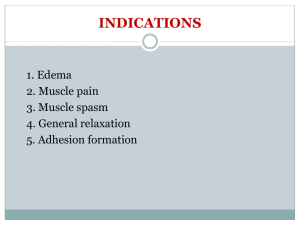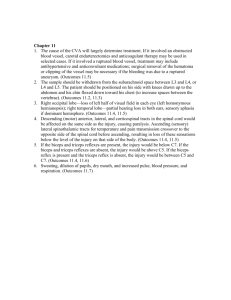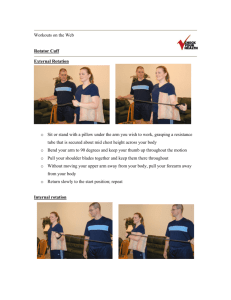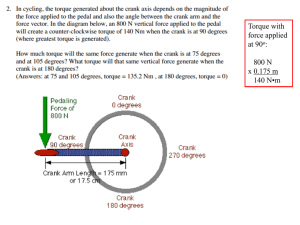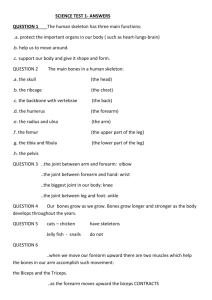Document 15349965
advertisement
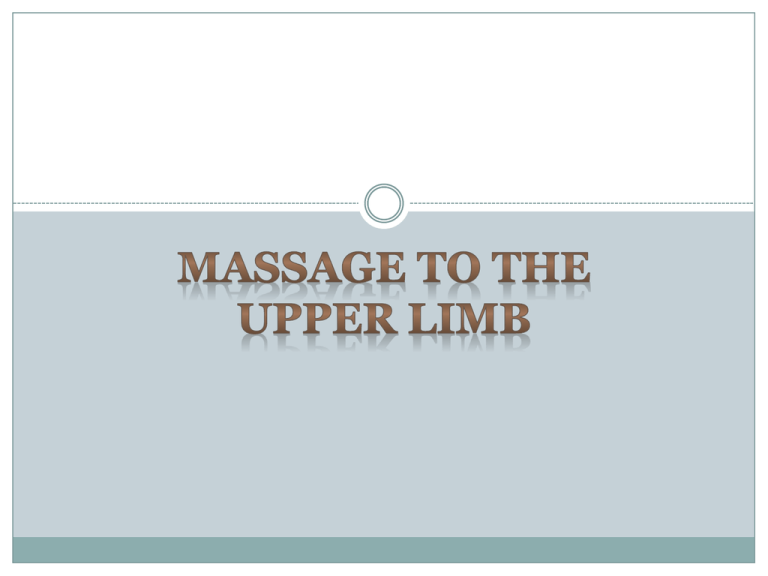
INDICATION 1. Edema 2. Muscle pain 3. Muscle spasm 4. Diabetic neuropathy 5. Periarthritis Shoulder 6. Tendinitis 7. Muscle atrophy PATIENT PREPARATION Position of the patient Supine lying position with adequate support. or Sitting position with arm abducted to 90 degrees and elbow flexed to 90 degrees and forearm pronated. Position of the therapist Walk standing position with your outer leg forward. Draping Entire body should be covered except the massaging arm (for female shoulder straps should be slipped off) Assessment before starting Before starting work, uncover the whole limb in order to examine it. Check by observation the state of the skin for abrasion and dryness, and the posture of joints, which may need extra support. Then palpate by running your hand down the length of each aspect of the limb. Note the temperature, tenderness and muscle tone. Ensure only light pressure over bony prominence. SEQUENCES FOR UPPER LIMB MASSAGE 1. 2. 3. 4. 5. 6. 7. 8. 9. Stroking (superficial) Effleurage Kneading Effleurage Picking up Effleurage Wringing Effleurage Hacking. 10. Effleurage. 11. Tapping. 12. Effleurage 13. Friction Effleurage to whole limb Effleurage to the upper limb is usually performed with one at a time while the order hand controls both the stability of the limb and the position of the hand. The grasp on the hand should be with your own palm cupped so you obtain a contact with only your own palm cupped so you obtain a contact with only your own palmar margins, so that a ‘ sticky’ grasp does not arise. Effleurage Extensor aspect Directions for effleurage: From little finger to axilla 2. From back of fingers to axilla 3. From thumb in mid pronation to axilla 1. Effleurage Flexor aspect From the thumb over the flexor surface of the forearm and the flexor surface of the arm to axilla 5. from the palmar aspect of the fingers over the front of the forearm and the anterior surface of the arm to the axilla. 6. from under the little finger, up the ulnar border of the forearm and the medial surface of the arm to the axilla. 4. Part strokes The shoulder. Upper arm. Forearm. hands. Interossoeus spaces. Digits. Kneading Always be aware that the size of the circle must be related to the size of the area under treatment. Ensure you are working on muscle or soft tissue and avoid deep, moving pressure over bony ridges and prominences. The pressure on all the manipulations should be inwards towards the centre of the arm and with upward pressure so that you can envisage assisting venous blood and lymph flow from distal to proximal. Double - handed alternate kneading It is usually performed straight down the length of the limb, from the shoulder to the finger tips, the hands start cupped over the shoulder and deltoid, encircle the upper arm to work on triceps and biceps, and turn at the elbow to lie obliquely on the flexor and extensor aspects of the forearm and hand. Kneading the deltoid. Kneading the biceps and triceps. Kneading on the forearm note the lifted position to facilitate the manipulation and the practitioner ’ s hands both in contact yet in different dispositions. Kneading on the hand Simultaneous thumb kneading to the abductor pollicis brevis and abductor digiti minimi. Single- handed alternate kneading The deltoid The triceps The biceps Extensors of the forearm Flexors of the forearm The hand. Finger kneading Thumb kneading Interosseous s paces Picking up It is usually performed with one hand at once, and from proximal to distal. The practitioner ’ s outer hand works on the deltoid, triceps and brachioradialis, and the inner hand on the biceps brachii and the forearm flexors. The free hand stabilises the limb adjacent to the working hand. The deltoid Picking up to deltoid – note the ‘ C ’ shape of the hand. The triceps Picking up to triceps – note the practitioner ’ s forearm is behind the model ’ s arm and the hand is ‘ C ’ shaped. The biceps Picking up to biceps – note the practitioner ’ s forearm is parallel with that of the model. The brachioradialis Picking up to brachioradialis – note the ‘ V ’ shape of the hand. Wringing Wringing is most easily performed on the long muscles of the triceps and biceps brachii. It is possible to wring a flabby or very relaxed deltoid, but the muscle is so short that it presents difficulties in performance. The The deltoid and triceps Muscle shaking The deltoid. The triceps. The biceps. The bachioradialis Muscle rolling Muscle rolling can be performed on each of the upper limb muscles which can be picked up. Brachioradialis. the two fl exor and two abductor muscles of the thenar and hypothenar eminences. Hacking and clapping
